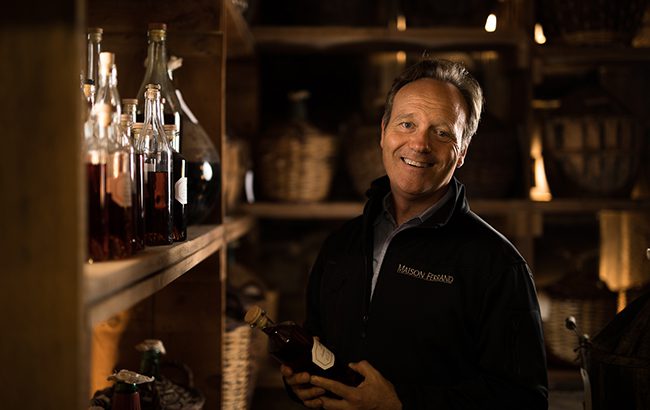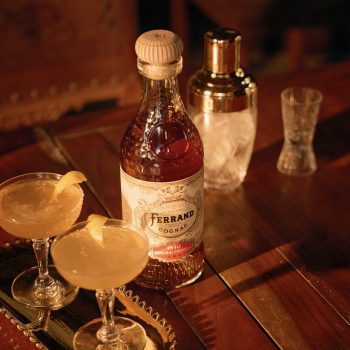Is the French market key to Cognac’s revival?
By Lauren BowesAlexandre Gabriel, owner and master blender of Maison Ferrand, reflects on a rocky few years for Cognac and explains why he believes the French are rediscovering their homegrown spirit.

It’s been a tough year for most spirits categories, but arguably none more so than Cognac. “The challenges are what’s happening with geopolitics,” says Alexandre Gabriel. “Cognac is rooted in history, and the history of Cognac is linked to the world.”
He believes Cognac’s global outlook goes right back to its origins in the late 1500s: when the British and Dutch asked producers on France’s west coast to distil their wines so they could survive long sea voyages. “It’s a spirit born from travelling,” he says. “And now it’s a different situation.”
Specifically, China threatened a provisional anti-dumping tariff on Cognac and EU brandy in August 2024, leaving the sector with a cloud of uncertainty for more than a year. Gabriel credits industry body the BNIC, the French government and EU negotiators for restoring most of the trade. “A few companies are not included in the agreement yet, but about 95% of the trade is recovered,” he says.
Even so, producers are still rebuilding. “When you restart, you need to pick up speed again. We were stopped in our tracks.”
Then, at a time when the sector should have been recovering from the China blow, it suffered yet another setback – tariffs from the US. “You’re talking here about the number two and number one markets for Cognac,” he says, adding that Russia was historically “very fond” of Cognac – which is another market that’s “basically gone”.
And while Cognac’s downturn has been a topic of conversation for at least two years, it wasn’t too long ago that the sector was a real success story. “Four years ago, I would have told you: ‘Well, we just don’t have enough Cognac to sell’,” he recalls. “It’s surreal.”

A home in France
There are signs of positivity, though – particularly in France. “I think French people are rediscovering Cognac,” he says. “It’s like a pendulum – like when Americans rediscovered Bourbon 20 years ago.”
This new consumer is “educated, young, curious”, and particularly interested in “a gastronomic experience that’s rooted in terroir”. He believes Cognac is uniquely positioned to meet this audience.
“Cognac has not only a long story to tell, but a beautiful story in terms of making,” he explains. “We all grow our own grapes. Locally, it’s a short production, even though it takes a long time to age. We don’t have to carry things across continents; our raw material is just over there. In our case, at Maison Ferrand, we grow from grapes to bottle.
“That’s something super important that I think French people are reconnecting with.”
He believes this message is landing. As evidence, he cites a Cognac festival held in Bordeaux this month (15 November) – the first of its kind in the city. “It was an incredible show,” adds Gabriel. “My team were amazed to see these super-young people. There were twice as many people as they were expecting.”
It’s a movement in the right direction, but not a panacea. “Of course, it’s not transformative economically right away,” he says. “You’re not going to see it in your balance sheet to replace China and the USA put together – but I think it’s so exciting and comforting.”
Maison Ferrand has been pushing for this, he says. “We’ve been hoping for the French to rediscover this beautiful spirit for a long time.”
A wider recovery
Gabriel also sees potential in neighbouring markets. “The UK was one of the early adopters of Cognac – we’re talking 400 years ago,” he says. “We would love Europe to start to play a beautiful role in Cognac again. What we’re seeing in France is encouraging.”
Euromonitor International forecasts that Cognac will decline by 5.9% by volume in 2025, and by 4.8% by value. At Maison Ferrand, however, Gabriel predicts a different trajectory. The company saw a dip in its usually strong US sales in 2024, but he predicts a “slide up” in 2025, in part because of strong performance in France.
“We’re doing great in France, and we’ve been focusing on France for 20 years really,” he explains. “I guess it’s like the weatherman – if you keep saying it’s going to be sunshine tomorrow, at one point, you’re right.”
This isn’t mere wishful thinking, however. Maison Ferrand and long-term distribution partner La Maison du Whisky have invested heavily in rebuilding the category at home. “We have four employees in the French market who are passionate, and who go from one bar to another, to tell the story of Cognac as much as they do about our two other brands [Planteray Rum and Citadelle Gin].
“Cognac is always there and always talked about. And I think we’re starting to see this creating a nice boost.”
La Maison du Whisky is also behind Whisky Live Paris (27-29 September), where Cognac has steadily grown its presence. “Cognac was doing very well there from a small base,” Gabriel explains. “The family businesses that were there were so excited to see all these people.”
He believes the audience at Whisky Live is primed to be the next Cognac consumer. “You know that customer – that connoisseur that likes something that’s got heritage, beautiful taste, integrity,” he explains. “Single malt has done great with that customer for many, many decades. Japanese whisky has done great with that customer.
“Some people have done well with rum. With Planteray, we know this customer very well. We love that customer. We see that customer being very receptive to Cognac right now.”
Cognac as an ecosystem
More importantly, Gabriel sees the sector as incredibly resilient – including its producers and négociants. “Even though it’s hard, they’re not giving up,” he adds. “It would be very sad to see. Some of these companies belong to big groups, and they could say: ‘You know what, we’re not going to sell a little more of this because this is difficult.’”
A rapid bounceback is unlikely, he warns. “A lot is going to depend on where the economy in the US goes,” he says. “But I can tell you that, as a region, we’re sticking together. We’re being very prudent in Cognac.”
He points to the web of local businesses that rely on the spirit: glassmakers, seed suppliers, coppersmiths, more than 100 coopers. “Cognac is really an ecosystem from the grape to the bottle,” he explains.
“I think we felt the pain maybe a little harder because it came after such a very good era,” he adds, pointing to the 20 years since around 2004, excluding the financial crisis of 2007-2009. “But Cognac bounced back so quickly. People were loving Cognac. Now we are readjusting.”
Importantly, the current issues with Cognac have nothing to do with the liquid, he believes. “It was not caused by customers saying: ‘I’m not going to drink Cognac any more.’ It was really the geopolitics – and inflation, but geopolitics was the major trigger.”
Inflation is particularly tough for Cognac because it is so expensive to produce. “Cognac has a high cost of production because grapes are one of the two or three fruits that are the hardest to grow,” Gabriel explains. “It’s a very expressive raw material – you chew on a piece of grape and it’s nice, right? It’s more expressive on its own that a lot of raw material. The downside to that is, of course, growing grapes is expensive.
“When you see a vineyard owner, they’re always complaining. Either it’s too much rain, not enough rain or whatever – you have to juggle with all of this.”
Previously, the ‘sweet spot’ for a spirit was between US$35 and US$45, but consumers today have less money to spend. “Some people argue it’s more like US$25 to US$30 now,” he says. “Some of the spirits can reach that sweet spot, but for Cognac, it’s much harder.”
In the past, people would treat themselves and spend US$45 on a “beautiful bottle” of Cognac. “Now some people may scratch their head – and that’s the inflation effect.”
Despite the turbulence, Gabriel remains optimistic. “I really believe in Cognac. I think it’s an eternal spirit,” he says. “Cognac has been around before my time for hundreds of years. You see these ups and downs in history.
“The big question is how long. What is next? That’s very uncharted – but we are resilient. The region has been doing this for 400 years. It’s going to be hard, but we’re going to continue doing what we do.”
Related news
Sazerac Cognac rekindles golden age with trio of releases
